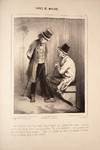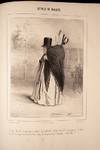first edition
by TRAVIES, Charles Joseph
Paris: Chez Aubert, 1840. Tweny-Five Fine Lithographs by Traviès Illustrating the Manners of the Parisiennes
TRAVIÈS, Charles Joseph. Scènes de Moeurs [Scenes of Manners]. Paris: Chez Aubert, [ca. 1840].
First edition. Folio (13 9/16 x 10 3/8 inches; 341 x 264 mm.). Twenty-five fine lithograph plates.
Bound ca. 1840 in quarter dark green calf over pebbled green cloth boards. Smooth spine decoratively tooled and lettered in gilt. Small paper label affixed to front cover lettered in ink "C.J. Travies/Scenes de Moeurs/25 lithos". Top of spine chipped, extremities a little rubbed, some minor light marginal foxing to a few plate. An excellent example of this amusing and very scarce suite of plates.
Rare: OCLC/KVK locate no copies in libraries and institutions worldwide.
Charles-Joseph Traviès 1804-1959). "Proclaimed the "Prince of Bad Luck" by Baudelaire, Charles -Joseph Traviès de Villers has often been overlooked by critics of French caricature, yet his rough and wispy crayon, so often accused of awkwardness, lends a piquancy and pathos to the working-class heroes he represents… His first prints date from 1822, and he worked fairly steadily until 1845. Described by the novelist Champfleury as storklike, Traviès had a penchant for drinking and for bals publiques especially those of the barrières. Champfleury records that once Traviès, dead drunk, had himself carried to the novelist's quarters in a body wagon. In contrast to the robust dandies and lorettes of Gavarni,
Traviès penetrates the humble sphere of the poor with touching sincerity and tenderness. His association with working-class people lent fuel to his tendency toward socialist sympathies. Travieès is credited with the invention of the irrepressible little republican hunchback Mayeux, whose antics enjoyed immense popular success not only in Traviès oeuvre but in the works of others as well. He was also the most important creator of images of the chiffonnier, the legendary Parisian ragpicker (plate 25), street philosopher of the people and the vanguard artist whose position in bourgeois society had become marginal. Traviès lithographs were published in Philipon's La Caricature and Le Charivari, where he became acquainted with Charlet, Grandville, and Daumier. Traviès only biographer, Claude Ferment, has indicated the importance of this caricaturist as an influence on Daumier and as a harbinger of the realist movement of the 1840's." (Beatrice Farwell. The Charged Image. p. 149 and illustration on p. 151).
Farwell. The Charged Image. p. 149 and illustration on p. 151; Ferment. Le Caricaturiste Traviès. (Inventory #: 06218)
TRAVIÈS, Charles Joseph. Scènes de Moeurs [Scenes of Manners]. Paris: Chez Aubert, [ca. 1840].
First edition. Folio (13 9/16 x 10 3/8 inches; 341 x 264 mm.). Twenty-five fine lithograph plates.
Bound ca. 1840 in quarter dark green calf over pebbled green cloth boards. Smooth spine decoratively tooled and lettered in gilt. Small paper label affixed to front cover lettered in ink "C.J. Travies/Scenes de Moeurs/25 lithos". Top of spine chipped, extremities a little rubbed, some minor light marginal foxing to a few plate. An excellent example of this amusing and very scarce suite of plates.
Rare: OCLC/KVK locate no copies in libraries and institutions worldwide.
Charles-Joseph Traviès 1804-1959). "Proclaimed the "Prince of Bad Luck" by Baudelaire, Charles -Joseph Traviès de Villers has often been overlooked by critics of French caricature, yet his rough and wispy crayon, so often accused of awkwardness, lends a piquancy and pathos to the working-class heroes he represents… His first prints date from 1822, and he worked fairly steadily until 1845. Described by the novelist Champfleury as storklike, Traviès had a penchant for drinking and for bals publiques especially those of the barrières. Champfleury records that once Traviès, dead drunk, had himself carried to the novelist's quarters in a body wagon. In contrast to the robust dandies and lorettes of Gavarni,
Traviès penetrates the humble sphere of the poor with touching sincerity and tenderness. His association with working-class people lent fuel to his tendency toward socialist sympathies. Travieès is credited with the invention of the irrepressible little republican hunchback Mayeux, whose antics enjoyed immense popular success not only in Traviès oeuvre but in the works of others as well. He was also the most important creator of images of the chiffonnier, the legendary Parisian ragpicker (plate 25), street philosopher of the people and the vanguard artist whose position in bourgeois society had become marginal. Traviès lithographs were published in Philipon's La Caricature and Le Charivari, where he became acquainted with Charlet, Grandville, and Daumier. Traviès only biographer, Claude Ferment, has indicated the importance of this caricaturist as an influence on Daumier and as a harbinger of the realist movement of the 1840's." (Beatrice Farwell. The Charged Image. p. 149 and illustration on p. 151).
Farwell. The Charged Image. p. 149 and illustration on p. 151; Ferment. Le Caricaturiste Traviès. (Inventory #: 06218)
































![Affiches Illustrèes [&] Gentilhommes Bourgeois [&] Des Mères de Famille](https://d3525k1ryd2155.cloudfront.net/h/809/855/1684855809.0.m.jpg)
![Baliverneries Parisiennes [Parisian Gossip]](https://d3525k1ryd2155.cloudfront.net/h/802/855/1684855802.0.m.jpg)